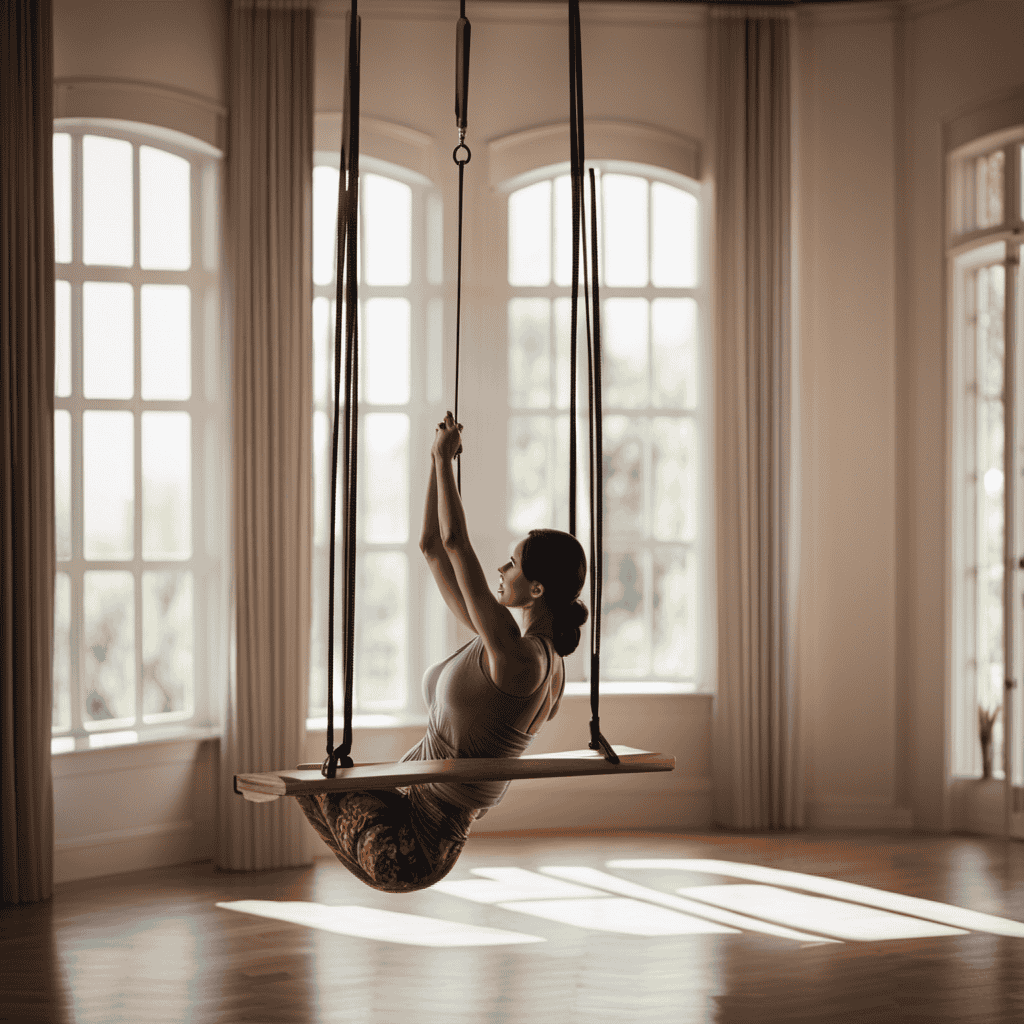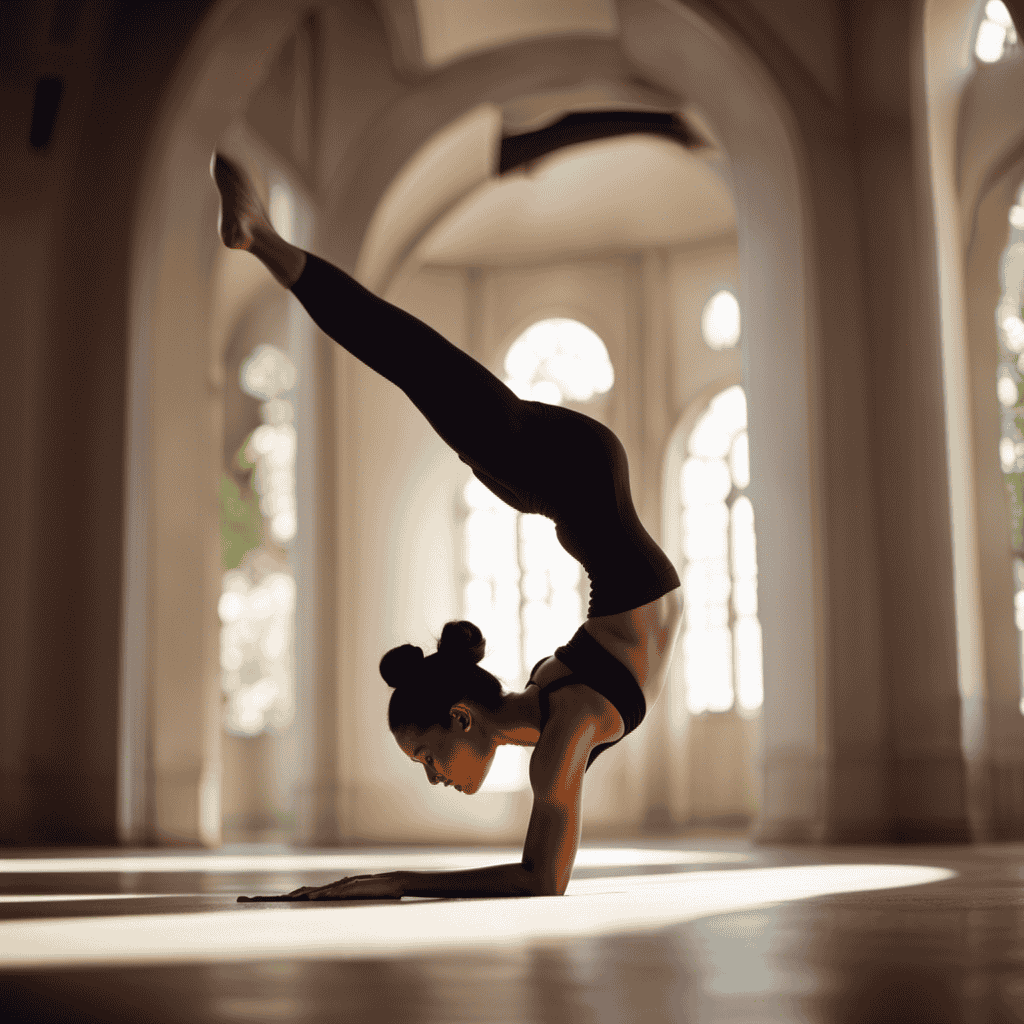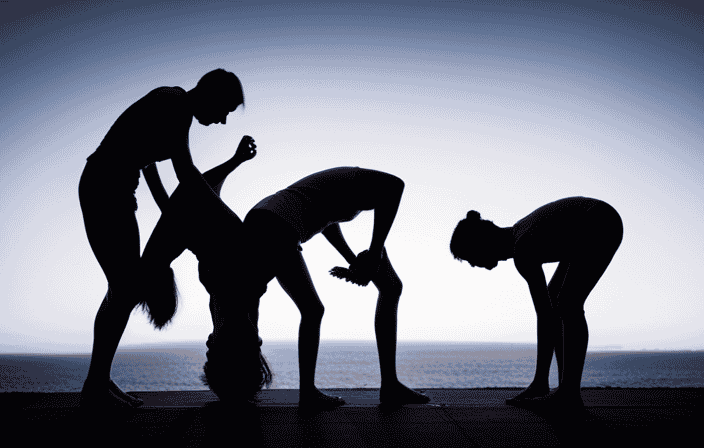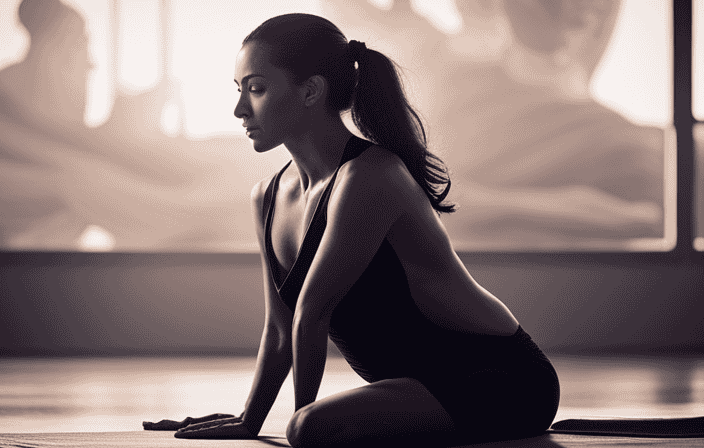Are you prepared to take your yoga practice to the next level? If you are, it’s time to become an expert at setting up a yoga swing.
Just imagine the freedom and flexibility that comes with incorporating this fabric hammock into your routine. Not only can it enhance your poses, but it can also improve your overall well-being.
However, before you take flight, it’s important to ensure you have the knowledge and tools to hang your swing safely and securely.
Let’s dive in and explore the steps, benefits, and safety considerations involved in this enlightening endeavor.
Key Takeaways
- Gather all necessary materials before starting the installation process, including anchors, a drill, and carabiners.
- Choose a suitable location for hanging the yoga swing, taking into consideration the weight capacity and condition of the ceiling or overhead structure.
- Consider the different types of yoga swings available, such as fabric, padded, and aerial swings, and choose one that suits your needs and preferences.
- Prioritize safety by regularly inspecting the swing, anchors, and carabiners for wear and tear, following the manufacturer’s instructions for maintenance, and addressing any potential issues early on.
How to Hang a Yoga Swing
I can easily hang a yoga swing by gathering the necessary materials, finding a suitable location, measuring and marking the ceiling accurately, installing the anchors using the right drill bit, and securing the swing with carabiners.
When it comes to choosing the right yoga swing, there are different types to consider. One option is a fabric yoga swing, which offers comfort and flexibility. Another option is a padded yoga swing, providing extra cushioning for added support. Additionally, there are aerial yoga swings that come with handles or stirrups for better grip and stability.
It’s important to choose a yoga swing that suits your specific needs and preferences. Consider factors such as weight capacity, fabric durability, and any additional features that may enhance your yoga practice.
Benefits of Yoga Swings
Using a yoga swing can lead to reduced stress and anxiety, increased flexibility, improved posture, enhanced balance and coordination, and a unique and enjoyable workout experience.
Yoga swing exercises offer a wide range of benefits for both the body and mind. They help to release tension in the muscles and promote relaxation, which can reduce stress and anxiety.
The swinging motion of the yoga swing also helps to stretch and lengthen the muscles, increasing flexibility over time.
Additionally, using a yoga swing can improve posture by strengthening the core and promoting proper alignment. It also enhances balance and coordination through the use of suspension and stability exercises.
When choosing the right yoga swing, it is important to consider factors such as weight capacity, fabric material, and adjustability for different poses and heights. Taking these factors into account will ensure a safe and effective yoga swing experience.
Safety Considerations
To ensure a safe installation, it is important to consider the weight capacity and condition of the ceiling or overhead structure before hanging a yoga swing. Choosing the right location is crucial, as it should have enough space and be able to support the weight of both the swing and the user. Additionally, using proper installation tools is essential to ensure a secure and stable setup. Before starting the installation process, it is recommended to gather all necessary materials, including the yoga swing, anchors, and a drill. Once the location has been chosen and measured accurately, the anchors can be installed using the right drill bit. Finally, the yoga swing can be secured with carabiners. Regularly inspecting for wear and tear and following the manufacturer’s instructions for maintenance will help ensure the safety and longevity of the yoga swing.
| Safety Considerations | Tips and Suggestions |
|---|---|
| Consider weight capacity and condition of ceiling or overhead structure | Check for any signs of damage or weakness in the ceiling or overhead structure. Ensure it can support the weight of the swing and user. |
| Choose the right location | Find a location with enough space for the swing and user to move freely. Ensure there are no obstructions or hazards in the surrounding area. |
| Use proper installation tools | Gather all necessary materials, including the yoga swing, anchors, and a drill. Use the appropriate drill bit to install the anchors securely. |
| Regularly inspect for wear and tear | Check the yoga swing, anchors, and carabiners for any signs of damage or wear. Replace any worn out or damaged components. |
| Follow manufacturer’s instructions for maintenance | Read and follow the manufacturer’s instructions for proper maintenance of the yoga swing. This includes cleaning, lubricating, and storing the swing correctly. |
Steps to Hanging
First, locate a suitable area in your space that provides enough room for the swing and user to move freely. This is crucial to ensure a safe and comfortable yoga swing experience.
Once you have found the perfect spot, it’s time to explore alternative hanging methods and consider the different types of yoga swings available.
When it comes to hanging a yoga swing, there are various options to choose from. Some yoga swings come with their own mounting systems, while others require installing anchors into the ceiling. It’s important to carefully follow the installation instructions provided by the manufacturer to ensure proper setup.
If you opt for a swing that requires anchors, gather the necessary materials such as the yoga swing itself, anchors, and a drill. Measure and mark the ceiling accurately to ensure a secure installation. Use the right drill bit to install the anchors, and make sure they are firmly secured.
Once the anchors are in place, it’s time to attach the yoga swing using carabiners. Ensure that the carabiners are properly tightened to prevent any accidents or injuries. Regularly inspect the swing for wear and tear, and follow the manufacturer’s instructions for maintenance.
By following these steps and considering alternative hanging methods and different types of yoga swings, you can confidently master the art of hanging a yoga swing in your space.
Troubleshooting Common Problems
When troubleshooting common problems with a yoga swing, it’s important to regularly check for wear and tear and follow the manufacturer’s instructions for maintenance.
One common issue that may arise is an uneven swing. To address this, adjust the anchors to ensure levelness.
Another problem that may occur is a loose swing. To fix this, simply tighten the carabiners securely.
On the other hand, if the swing feels too tight, you can adjust the tension by using a spring.
It’s crucial to regularly inspect the swing for any signs of wear and tear, such as fraying or weakening of the fabric. By doing so, you can address any potential issues early on and ensure the longevity and safety of your yoga swing.
Remember to always follow the manufacturer’s instructions for maintenance to keep your swing in optimum condition.
Frequently Asked Questions
Can a yoga swing be used outdoors?
Yes, a yoga swing can be used outdoors. Outdoor yoga swing practice offers several benefits, such as enjoying fresh air and connecting with nature. The best outdoor locations for yoga swing practice include parks, gardens, and spacious backyards.
How do I clean a yoga swing?
To clean a yoga swing, I recommend using a mild detergent and warm water. Gently scrub the fabric with a soft brush, then rinse thoroughly and allow to air dry. Avoid using harsh chemicals or bleach.
Can I hang a yoga swing in an apartment?
Yes, you can safely hang a yoga swing in an apartment by finding the right support. Ensure the ceiling or overhead structure is sturdy enough to hold the weight. Use anchors and a drill to securely install the swing.
What is the weight limit for a yoga swing?
The weight limit for a yoga swing depends on the specific model and manufacturer. It is important to check the product’s specifications before installation. The installation process typically involves securing the swing with carabiners and ensuring proper anchoring for stability.
Can children use a yoga swing?
Sure, children can use a yoga swing! It’s important to prioritize children’s safety by ensuring proper installation and supervision. Yoga swings offer numerous benefits for kids, including improved flexibility, strength, balance, and coordination.
Conclusion
In conclusion, mastering the art of hanging a yoga swing can open up a world of possibilities for enhancing your yoga practice and improving your well-being.
By following the necessary safety precautions and steps, you can create a safe and supportive environment for enjoying the benefits of a yoga swing.
Remember to regularly inspect and maintain your swing to ensure its longevity.
So why wait? Take the leap and elevate your yoga experience with a yoga swing – it’s time to soar to new heights of flexibility, balance, and relaxation.
Embrace the freedom and liberation that comes with floating in the air, and let your body and mind find harmony.









